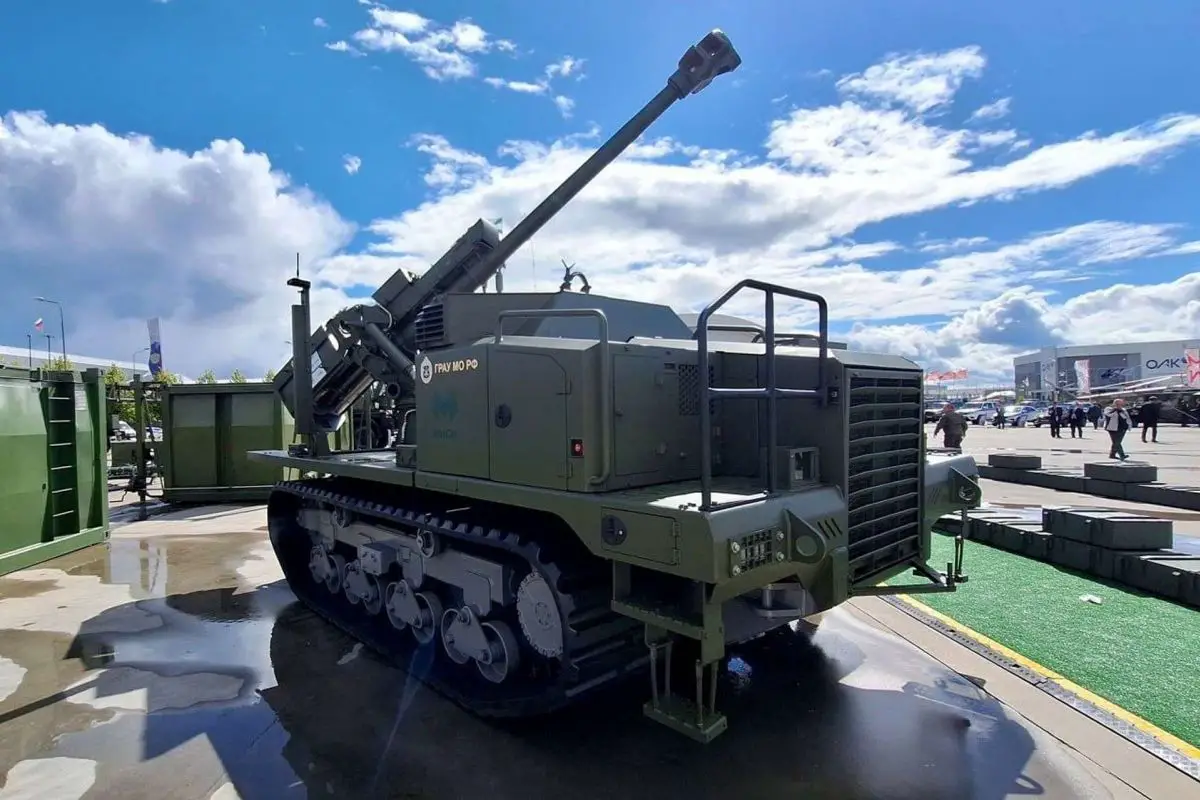Breaking News
Russia to deploy new unmanned MTS-15 Klever 122 mm self-propelled howitzer in Ukraine.
According to Wpristav.su, on August 14, 2024, the MTS-15 Klever, a new unmanned ground vehicle (UGV) equipped with a D-30 122 mm howitzer recently presented at the Army-2024 exhibition, is scheduled to be sent to Ukraine for full-scale testing in combat conditions. The MTS-15 Klever is designed to function as a remote-controlled artillery system that can be operated by a single operator from a distance of up to 500 meters.
Follow Army Recognition on Google News at this link

The prototype of the MTS-15 Klever has undergone testing at a proving ground and is now set to be tested in a real combat environment. (Picture source: Russian social media)
The prototype of the MTS-15 Klever has undergone testing at a proving ground and is now set to be tested in a real combat environment. The deployment to the combat zone in Ukraine is expected to occur in the near future, according to an informed source. The MTS-15 Klever can move at a speed of 12 kilometers per hour, with its cruising range reported as 400 kilometers by the developers, though other sources suggest it might be closer to 120 kilometers.
The gun is equipped with an automatic loader for four shots, and its other characteristics remain consistent with the D-30 howitzer. The system can transition to a combat position and back in approximately 30 seconds. No additional details have been provided.
The system is controlled remotely, but human intervention is still required to make corrections for shooting after each shot. Typical operation involves the self-propelled howitzer moving to a firing position, with the crew aiming the gun and then taking cover. The MTS-15 Klever then opens fire, and if adjustments are needed, the crew can input them. Once the ammunition is depleted, the robot autonomously moves to reload, with the crew following on an ATV or buggy.

The system is controlled remotely, but human intervention is still required to make corrections for shooting after each shot. (Picture source: Telegram/Btvt.info)
The D-30 howitzer, which forms the core of the MTS-15 Klever system, is a Soviet-designed 122-mm artillery piece developed in the late 1950s to replace the older M-30 howitzer, which had been in service since World War II. The D-30 was introduced into service in the early 1960s and is known for its three-leg mounting system that allows for a 360-degree traverse. This design was intended to provide greater stability and flexibility. The D-30 has been widely exported and used by Warsaw Pact nations and other Soviet allies, making it a common artillery system in many military forces worldwide.
The D-30 has seen extensive use in conflicts such as the Iran-Iraq War, the Afghan-Soviet War, and the Syrian Civil War. Its widespread use is attributed to its operational reliability and suitability for diverse combat environments. Some countries have developed local variants of the D-30, including Algeria, which mounted it on a Mercedes-Benz truck, and China, which produced versions like the Type 86 and Type 96. The D-30 continues to be used by many nations, especially in developing regions, highlighting its continued relevance in modern military operations.
As a 122-mm towed howitzer, the D-30 weighs approximately 3.2 tons and has a barrel length of 4.875 meters. It has a maximum range of 15.4 kilometers with standard high-explosive fragmentation (HE-Frag) shells, extendable to 21.9 kilometers with rocket-assisted projectiles. The howitzer can maintain a firing rate of 7-8 rounds per minute. Its three-leg carriage design enables rapid deployment and stabilization, which is important for maintaining accuracy in long-range firing. Additionally, the D-30 is equipped with a multi-slotted muzzle brake to manage recoil.

The MTS-15 Klever can move at a speed of 12 kilometers per hour, with its cruising range reported as 400 kilometers by the developers, though other sources suggest it might be closer to 120 kilometers. (Picture source: Telegram/Btvt.info)


























